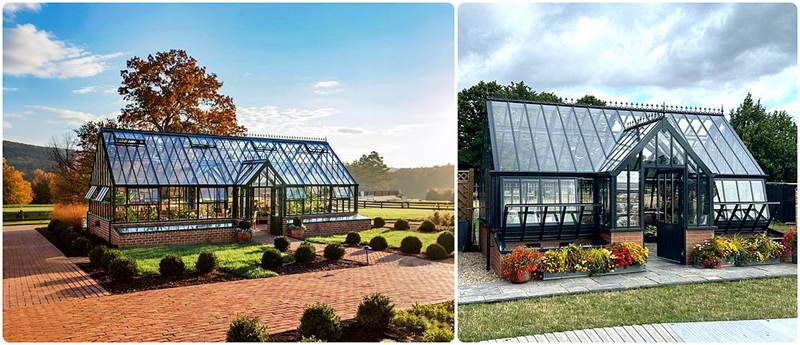
Year-Round Gardening: Maximizing Your Victorian Greenhouse
Want fresh veggies and flowers all year? Your Victorian greenhouse makes it possible! These beautiful glass greenhouses with their sturdy steel and glass structure are perfect for growing everything from winter greens to summer tomatoes. I'll show you simple tricks to keep plants happy in every season - from beating the heat in July to protecting tender plants in January. Learn how to get the most from your classic greenhouse with easy climate control, smart planting schedules, and low-cost maintenance tips that really work!

There’s something magical about tending to plants inside a Victorian greenhouse. With its elegant steel and glass structure, this timeless glass greenhouse design isn’t just beautiful—it’s a powerhouse for growing everything from delicate orchids to hearty winter greens, no matter the season.
If you’re lucky enough to own one of these classic structures (or are thinking about getting one), this guide will help you make the most of it. We’ll cover:
-
Why Victorian greenhouses outperform modern designs
-
Best plants for year-round growing
-
Seasonal maintenance tips
-
Cost-effective climate control tricks
Why Choose a Victorian Greenhouse?
While modern polycarbonate greenhouses have their perks, there’s a reason glass greenhouses—especially Victorian-style ones—remain popular after 150+ years:
✔ Superior Light Transmission – Glass lets in 90% of sunlight (vs. 70-80% with plastic), crucial for winter growth.
✔ Built to Last – The steel and glass structure withstands decades of use (many originals still thrive today).
✔ Natural Temperature Regulation – Tall roofs and vents prevent overheating better than squat modern designs.
✔ Timeless Aesthetic – Ornamental details make it a garden focal point, not just a functional space.
Pro Tip: If buying new, opt for tempered safety glass—it’s more durable than traditional panes.
Spring: Kickstarting Your Growing Season
Best Plants to Start Early:
-
March: Tomatoes, peppers, and eggplants (start seeds in heated propagators)
-
April: Salad greens, herbs (direct sow in beds)
-
May: Tender flowers like pelargoniums
Key Tasks:
☑ Deep Clean – Scrub glass with vinegar solution to maximize light after winter grime.
☑ Check Seals – Replace cracked putty around panes to prevent drafts.
☑ Pest Patrol – Aphids love new growth; introduce ladybugs early.
Victorian Advantage: The steep roof angle sheds spring rain efficiently, preventing algae buildup.
Summer: Beating the Heat
Heat Management Tricks:
-
Automatic Vents – Install solar-powered openers (original designs relied on manual pulleys).
-
Shade Cloth – Drape over roof during heatwaves (30-50% density works for most plants).
-
Damp Down – Wet gravel floors in the morning for natural evaporative cooling.
Top Summer Crops:
-
Cucumbers (train up trellises)
-
Citrus trees in pots
-
Heat-loving succulents
Did You Know? The oldest working Victorian greenhouse (Tatton Park, UK) keeps tropical fruit at 28°C/82°F without AC using just shade and airflow.
Autumn: Preparing for Winter Abundance
Extend Your Harvest With:
-
Leafy Greens – Swiss chard, kale, and spinach thrive in cooling temps.
-
Root Veggies – Carrots and beets grow slower but sweeter.
-
Winter Blooms – Cyclamen and hellebores add color.
Must-Do Maintenance:
✓ Insulate Base – Stack straw bales against lower glass panels.
✓ Install Bubble Wrap – Temporary inner layer cuts heat loss by 30%.
✓ Service Heating – Test pipes or electric heaters before frost hits.
Steel & Glass Tip: Wipe down metal frames with linseed oil to prevent winter rust.
Winter: The Secret Growing Season
What You Can Still Grow:
-
Microgreens – Ready in 2-3 weeks on heated mats.
-
Herbs – Parsley, chives, and thyme tolerate cold snaps.
-
Forced Bulbs – Hyacinths and paperwhites for holiday scent.
Winter Care Checklist:
❄ Snow Removal – Brush off heavy snow immediately (glass can handle it, but reduces light).
❄ Condensation Control – Run a dehumidifier to prevent mold.
❄ Light Supplement – Add LED grow lights for 4 extra hours on gloomy days.
Real-World Example: A Maine gardener grows lemons year-round in an unheated Victorian greenhouse using just compost-heated beds!

Year Round Gardening for Victorian Greenhouse
Cost-Saving Hacks for Your Glass Greenhouse
-
DIY Thermal Mass – Paint barrels black, fill with water; they’ll absorb heat by day and release it at night.
-
Repurpose Materials – Use old baking trays as seedling drip catchers.
-
Natural Pest Control – Grow marigolds and garlic between crops to deter bugs.
Final Thoughts
A well-maintained Victorian greenhouse isn’t just a relic—it’s the ultimate steel and glass structure for serious gardeners. By working with its natural advantages (light, airflow, durability), you can harvest fresh produce every month while enjoying a slice of horticultural history.
Ready to start? Share your Victorian greenhouse journey in the comments—we’d love to hear which heirloom varieties thrive in yours!
Why Choose Us?
- As the first manufacturer in China to introduce the Victorian conservatory design from Europe, we have 36 years of production experience since 1988, and our products are distributed in 68 countries.
- We have a professional team of 8 conservatory design engineers and 60 production workers. We are equipped with 2 hot-dip galvanizing machines, 2 steel shot blasting machines, and 1 spray line.
- Our professional design team can provide theoretical calculation data support for wind pressure resistance, earthquake resistance, and snow resistance of large-scale steel structure conservatories.
- Strict quality control. 8 inspection stages: raw material inspection, cutting and blanking size inspection, welding quality inspection, hot-dip galvanizing quality inspection, spray quality inspection, assembly quality inspection, and packaging quality inspection. Ensuring smooth assembly of the products, no rust, no leakage, and compliance with customer national standards.
- We cooperate with many well-known architectural design companies worldwide.
- Customized services. We can customize according to customer designs and dimensions. We also provide supporting facilities such as electric sunshades and air conditioners.
- We offer installation dispatch services, inspection services, and free replacement of parts. We also present high-value exquisite gifts.
- Video factory tour. You can view the entire production process.
Ready to Bring Your Greenhouse to Life?
Share your ideas and we'll create a custom solution just for you. Your email address will not be published. Required fields are marked *




